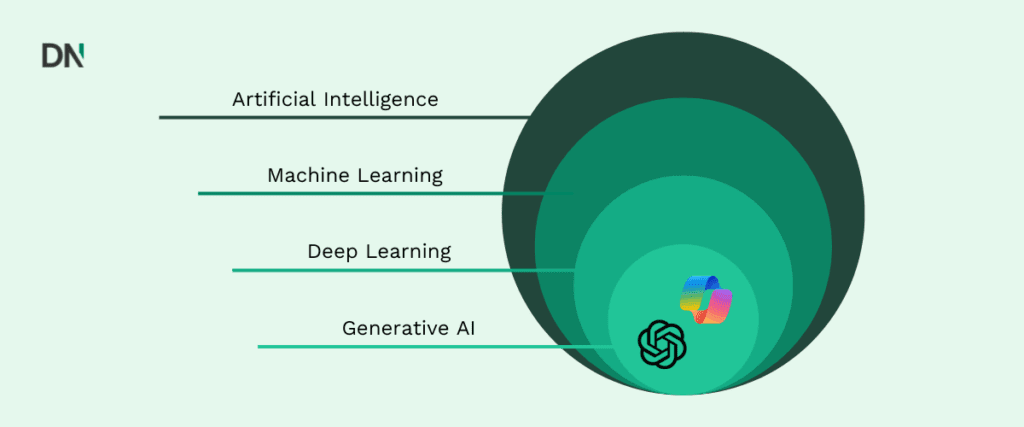What is Machine Learning
Often used interchangeably, Artificial Intelligence and Machine Learning are distinct yet deeply interconnected fields. This article will explain the core principles of Machine Learning and highlight why it’s absolutely crucial to the advancements we see in Artificial Intelligence.
What exactly is machine learning?
Machine learning is a subfield of artificial intelligence that allows computers to learn from data and make predictions or decisions without being explicitly programmed for every single task. Don’t think of it like giving a computer a rigid set of instructions, it’s more like teaching a child by showing them many examples.
The machine observes large amounts of information, identifies patterns within the data and then applies these learned patterns to new, unseen data to make future predictions or perform intelligent tasks. The more data a machine learning system processes, the more it learns and improves accuracy over time.

How does machine learning work?
The process of Machine learning involves several steps.
- Data Collection: It all begins with gathering the right information. This can be anything from images, text, sounds, or numerical figures. The quality and relevance of this data is important, as the model learns directly from it.
- Data Preparation: Raw data isn’t always “clean”. This step involves cleaning, standardising, removing inaccuracies, addressing errors, filling in missing values, and transforming data into a suitable format for the algorithm. This can be the most time-consuming part, especially with large datasets.
- Model Training: With clean, prepared data, the machine learning algorithm is trained. The goal is for the model to “learn” patterns and relationships within the data. It adjusts its internal parameters iteratively to minimise errors between its predictions and the actual outcomes. This iterative “evaluate and optimise” process continues until a desired level of accuracy is met.
- Model Evaluation: After training, the model’s performance is assessed using a separate dataset that it hasn’t seen before, called the test set. This helps determine how well the model can generalise its knowledge to new situations
- Model Improvement: If the model’s accuracy isn’t up to par, it can be refined through techniques like hyperparameter tuning and cross-validation, which help improve performance and prevent issues like overfitting
Note: The core components that make this possible are the algorithms (the set of rules the machine follows), the data (the fuel for learning), and the model training process itself.
Types of machine learning
There are four primary types that are suited for different tasks:
- Supervised learning: This is the most common type, where the algorithm learns from “labelled data”. This means the input data comes with corresponding correct outputs or answer keys.
- Unsupervised learning: In this method, the algorithm works with “unlabelled data”, meaning there are no predefined answers. It automatically discovers hidden patterns, structures, or groupings within the data.
- Semi supervised learning: This approach combines aspects of both supervised and unsupervised learning. It uses a small amount of labelled data to guide the learning process, then leverages a larger volume of unlabelled data to complete the model This method is useful when data labelling is costly or time-consuming.
- Reinforcement learning: Here, an “agent” learns to make decisions by interacting with an environment through trial and error. The agent receives rewards for correct actions and penalties for mistakes, continuously optimising its strategy to maximise its cumulative reward. This type of learning is prevalent in areas like game-playing AI and robotics.
Why is machine learning important to AI
Machine learning is fundamental to artificial intelligence because it provides the mechanisms for AI systems to learn, adapt, and improve over time. Without ML, AI would largely be limited to rule based systems that require explicit programming for every scenario.
Machine learning allows:
Exceed or match human capabilities: AI’s goal is to simulate human intelligence, which involves abilities like discovery, inference, and reasoning. Machine Learning is the primary way AI systems achieve these capabilities by finding patterns and making predictions based on large amounts of data.
Handle complex, unstructured data: ML (particularly its subfield Deep Learning) excels at processing complex, unstructured data like images, audio, video, and text. Deep learning uses neural networks with multiple layers to mimic the human brain’s structure, allowing it to discern intricate and abstract features. This is crucial for advancements in areas like computer vision and natural language processing
Drive generative AI: The recent “explosion” of generative AI, including large language models (LLMs) and chatbots like ChatGPT, is directly attributed to advanced machine learning and deep learning architectures, such as Transformer models and Foundation Models. These technologies allow AI to create new, original content dynamically, revolutionising how we interact with information.
Automate and optimise: ML algorithms automate complex data analysis tasks, uncover hidden insights, and enable systems to make data-driven decisions more efficiently than traditional methods or human analysis
Real-World Applications of Machine Learning
Machine Learning is already interwoven into our daily lives, often without us even realising it:
Recommendation Systems: Platforms like Netflix, Spotify, and Amazon use ML to suggest products, movies, or songs based on your past behaviour and preferences, leading to more personalised experiences.
Fraud Detection: Banks and financial institutions heavily rely on ML algorithms to identify suspicious transactions and protect customers from monetary losses.
Image and Speech Recognition: From tagging friends in social media photos to voice assistants like Siri and Alexa, ML enables computers to understand and process visual and auditory information.
Natural Language Processing (NLP): ML powers capabilities like language translation, sentiment analysis, and the development of intelligent chatbots and virtual assistants.
Self-Driving Cars: Autonomous vehicles use ML (including supervised, unsupervised, and reinforcement learning) to perceive their surroundings, predict other vehicles’ behaviour, and make real-time decisions to navigate safely.
Medical Diagnosis and Personalised Treatment: ML helps doctors diagnose diseases earlier, predict outbreaks, and tailor treatment plans based on patient data.
Final thoughts
As a critical subfield of AI, ML’s ability to learn from data and improve autonomously is what drives most of the AI applications we see today, from conversational chatbots to medical diagnostics and beyond. The future of AI is undeniably bright, with Machine Learning at its very core, constantly pushing the boundaries of what machines can achieve.
Navigating the complexities of data collection and preparation, choosing the right algorithms, preventing biases, and ensuring ethical implementation requires specialised knowledge. If your business is ready to unlock the potential of Machine Learning and AI to drive innovation, enhance efficiency, and gain a competitive edge, we are here to guide you through every step with our Machine Learning consultancy.
Get in touch with us today to explore the possibilities!






